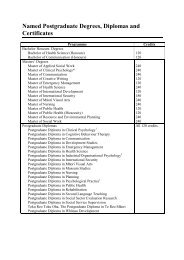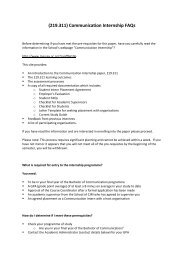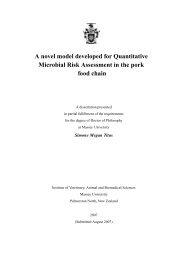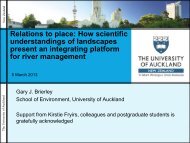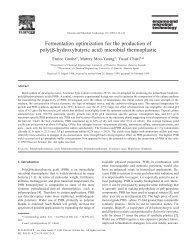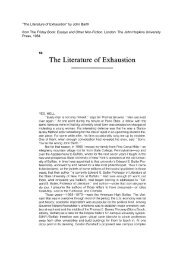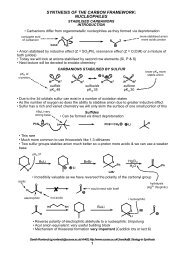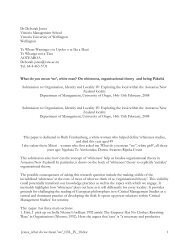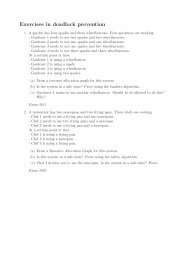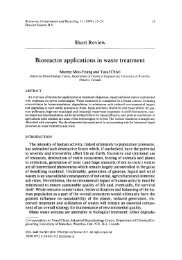PDF version - Massey University
PDF version - Massey University
PDF version - Massey University
Create successful ePaper yourself
Turn your PDF publications into a flip-book with our unique Google optimized e-Paper software.
Computational Science Technical Note CSTN-111<br />
Comparison of GPU Architectures for Asynchronous Communication with<br />
Finite-Di↵erencing Applications<br />
D. P. Playne and K. A. Hawick<br />
2011<br />
Graphical Processing Units (GPUs) are good data-parallel performance accelerators for solving regular mesh partial<br />
di↵erential equations (PDEs) whereby low-latency communications and high compute to communications ratios can<br />
yield very high levels of computational e ciency. Finite-di↵erence time-domain methods still play an important role<br />
for many PDE applications. Iterative multi-grid and multilevel algorithms can converge faster than ordinary finite<br />
di↵erence methods but can be much more di cult to parallelise with GPU memory constraints. We report on some<br />
practical algorithmic and data layout approaches and on performance data on a range of GPUs with CUDA. We<br />
focus on the use of multiple GPU devices with a single CPU host and the asynchronous CPU/GPU communications<br />
issues involved. We obtain more than two orders of magnitude of speedup over a comparable CPU core.<br />
Keywords: finite di↵erences methods; packed-data; GPUs; simulations<br />
BiBTeX reference:<br />
@ARTICLE{CSTN-111,<br />
author = {D. P. Playne and K. A. Hawick},<br />
title = {{Comparison of GPU Architectures for Asynchronous Communication with<br />
Finite-Differencing Applications}},<br />
journal = {Concurrency and Computation: Practice and Experience (CCPE)},<br />
year = {2011},<br />
volume = {Online},<br />
pages = {1-11},<br />
month = {7 April},<br />
address = {Albany, North Shore 102-904, Auckland, New Zealand},<br />
doi = {10.1002/cpe.1726},<br />
institution = {<strong>Massey</strong> <strong>University</strong>},<br />
keywords = {finite differences methods; packed-data; GPUs; simulations},<br />
owner = {kahawick},<br />
timestamp = {2010.09.16},<br />
url = {http://onlinelibrary.wiley.com/doi/10.1002/cpe.1726/abstract}<br />
}<br />
This is a early preprint of a Technical Note that may have been published elsewhere. Please cite using the information<br />
provided. Comments or quries to:<br />
Prof Ken Hawick, Computer Science, <strong>Massey</strong> <strong>University</strong>, Albany, North Shore 102-904, Auckland, New Zealand.<br />
Complete List available at: http://www.massey.ac.nz/~kahawick/cstn<br />
�<br />
0<br />
�<br />
�
CONCURRENCY AND COMPUTATION: PRACTICE AND EXPERIENCE<br />
Concurrency Computat.: Pract. Exper. 2010; 00:1–27 Prepared using cpeauth.cls [Version: 2002/09/19 v2.02]<br />
Comparison of GPU<br />
Architectures for Asynchronous<br />
Communication with<br />
Finite-Differencing Applications<br />
D.P. Playne ⇤ and K.A. Hawick †<br />
Institute of Information and Mathematical Sciences, <strong>Massey</strong> <strong>University</strong> – Albany, North Shore 102-904,<br />
Auckland, New Zealand.<br />
SUMMARY<br />
Graphical Processing Units (GPUs) are good data-parallel performance accelerators for solving regular<br />
mesh partial differential equations (PDEs) whereby low-latency communications and high compute to<br />
communications ratios can yield very high levels of computational efficiency. Finite-difference time-domain<br />
methods still play an important role for many PDE applications. Iterative multi-grid and multilevel<br />
algorithms can converge faster than ordinary finite difference methods but can be much more difficult<br />
to parallelise with GPU memory constraints. We report on some practical algorithmic and data layout<br />
approaches and on performance data on a range of GPUs with CUDA. We focus on the use of multiple GPU<br />
devices with a single CPU host and the asynchronous CPU/GPU communications issues involved. We obtain<br />
more than two orders of magnitude of speedup over a comparable CPU core.<br />
KEY WORDS: finite-difference; GPU; multiple device; CUDA.<br />
1. INTRODUCTION<br />
Graphical Processing Units (GPUs) have given data-parallel computing a new lease of life through<br />
their highly-efficient tightly-coupled computational capabilities within a single compute device. While<br />
further improvement in chip fabrication techniques will undoubtedly lead to yet more cores on a single<br />
device it is already also quite feasible to consider application programs that make use of multiple<br />
devices. This architectural notion of a CPU serviced by a small to medium number of separate GPU or<br />
similar accelerator devices is a particularly attractive way of increasing the power of individual nodes<br />
of a cluster computer or supercomputer [1] using off-the shelf technological components.<br />
⇤ Correspondence to: IIMS <strong>Massey</strong> <strong>University</strong> – Albany, North Shore 102-904, Auckland, NZ.<br />
† E-mail: {k.a.hawick, d.p.playne}@massey.ac.nz<br />
Received 1 September 2010<br />
Copyright c 2010 John Wiley & Sons, Ltd. Revised 1 September 2010
2 K. A. HAWICK AND D. P. PLAYNE<br />
Figure 1. A sample visualisation of a three-dimensional Cahn-Hilliard finite-differencing simulation.<br />
In this paper we look at software and ideas for managing multiple GPUs from a single CPU host –<br />
that may itself have one or more likely several conventional cores. We look at the asynchronicity issues<br />
and latency hiding potential for employing multiple host level threads within a single application,<br />
whereby each host thread runs a separate GPU device. We use and compare a trio of NVIDIA’s<br />
GTX260 GPU device cards and we extend the work reported in [2] with performance data and analysis<br />
on a pair of GTX480 device cards.<br />
A classic application problem in computational science [3, 4] is that of regular-structured hypercubic<br />
mesh [5] of floating-point field values upon which a partial differential equation (PDE) is solved<br />
iteratively using spatial stencils which provide discretised finite-difference operators.<br />
Key issues that arise are how to arrange the problem data domain in the memory of the computational<br />
device(s) to minimise overall communications of cell halos or where to asynchronously overlap<br />
communications with computations [6]. Work has been reported elsewhere on these issues for a single<br />
host thread and a single GPU accelerator device [7]. In this present paper we focus on multiple device<br />
effects and the particular problems that arise from yet another hierarchical layer in memory access<br />
speed.<br />
The use of GPUs to accelerate this sort of regular finite-difference calculation is not new. Researchers<br />
reported obtaining GPU speedups (over single CPU core) of around factors of eight [8] to twenty [9]<br />
on GPUs of vintage 2003 on similar problems to the ones we discuss and even for more sophisticated<br />
solver-methods such as the method of moments [10] where the data structures are harder to map to the<br />
GPU. Finite-difference method speedup on GPUs has been reported more recently between 2009 and<br />
Copyright c 2010 John Wiley & Sons, Ltd. Concurrency Computat.: Pract. Exper. 2010; 00:1–27<br />
Prepared using cpeauth.cls
ASYNCHRONOUS COMMUNICATION WITH CUDA 3<br />
2010 as around a factor of forty for application problems in fluid dynamics [11] and in computational<br />
electromagnetics [12]. There have however been very few reported works on use of multiple GPU<br />
devices hosted by a single CPU. Egloff reports obtaining a speedup of around twenty-five with a single<br />
GPU and a speedup of around forty with two devices using a tridiagonal solver approach [13]. Our<br />
experience has been that performance speedups of between one hundred and two hundred are possible<br />
– but these do require detailed and programmer-intensive optimisations to make use of GPU memory<br />
layout and also the multiple device management ideas that we present in this current paper.<br />
Halo issues in memory [14] and stencil-based problems [15] are also not new and have been widely<br />
experimented upon for many different software architectures and problems in parallel computing.<br />
Many applications in science and engineering can be formulated in this way [4] and can therefore<br />
make use of cluster supercomputers with nodes that have been accelerated with multiple devices.<br />
Applications range from those that involve simple stencil problems [16] in financial modelling [17]<br />
and in fluid mechanics [18], through complex stencils coding involving non-trivial data types such as<br />
vectors or complex numbers [19, 20], to those problems that couple multiple simple models together<br />
such as weather [21], environmental [22] and climate simulation codes [23].<br />
We focus on regular-structured mesh with direct storage, but these ideas relate to other problems<br />
that can be formulated in terms of sparse matrices [24]. We illustrate our approach and results using<br />
code implemented in NVIDIA’s Compute Unified Device Architecture (CUDA) – which is a C-based<br />
syntactic language highly suited to NVIDIA’s Tesla GPU devices [25]. Our host code running on<br />
conventional CPU core(s) employs straight C code and the pThreads library for multi-core functionality<br />
[26].<br />
This approach targets applications that can be decomposed into asynchronously-coupled individual<br />
computational kernels that are themselves intrinsically tightly coupled data-parallel computations. The<br />
latency balance points are unusual however because of the memory decompositions possible between<br />
the CPU main memory and the various sorts of memory available on the GPU devices themselves.<br />
In Section 4 we summarise the GPU architecture and describe the application problem in Section 5.<br />
In Section 7 we present some performance results which are discussed in terms of the various<br />
asynchronous tradeoff possibilities and tradeoffs possible in Section 8 where we also offer some<br />
conclusions and areas for further work experimenting with asynchronous support devices and in<br />
particular for building clusters with multiple GPU devices on each node.<br />
2. FINITE DIFFERENCE EQUATIONS<br />
Finite-difference methods for solving partial differential equations on regular structured meshes<br />
generally lend themselves well to implementation on GPUs with CUDA [16]. The general method<br />
involves approximating spatial calculus operators such as derivatives<br />
or the Laplacian<br />
@ @ @<br />
·, ·, ·, ... (1)<br />
@x @y @z<br />
r 2 ⌘ @2 @2 @2<br />
+ +<br />
@x2 @y2 @z<br />
2 ·, ... (2)<br />
Copyright c 2010 John Wiley & Sons, Ltd. Concurrency Computat.: Pract. Exper. 2010; 00:1–27<br />
Prepared using cpeauth.cls
4 K. A. HAWICK AND D. P. PLAYNE<br />
Figure 2. Some common memory halos in two and three dimensions. The light grey cells denote cells that would<br />
be used in the calculation of the finite-difference equation.<br />
with explicit difference formulae discretised on the spatial (regular) mesh. So for example (in two<br />
dimensions) the Laplacian can be approximated by:<br />
1<br />
2 (ux,y,z 1 + ux,y 1,z + ux 1,y,z 6ux,y,z + ux+1,y,z + ux,y+1,z + ux,y,z+1) (3)<br />
where is the spatial distance between cells. This direct method extends to some quite complicated<br />
operators such as the biharmonic operator (r 4 ·), and other situations where operators can be<br />
composited or otherwise combined [20]. Equations of the general form:<br />
u(r,t)<br />
dt<br />
= F(u, r,t) (4)<br />
where the time dependence is a first derivative and the spatial dependence in the right hand side is<br />
expressed in terms of an additive list of partial spatial derivatives, can be time-integrated using finitedifference<br />
methods. Although for explanatory purposes it is often easiest to use the first-order Euler<br />
time-integration method, in practice it is straightforward to apply other second-, fourth- or higher -order<br />
methods such as Runge-Kutta [27], once the spatial operators can be coded.<br />
3. Memory Halo<br />
Field equations using finite-differencing time-domain solvers almost always access the values of<br />
neighbouring cells to determine how to change the value of a cell. The neighbours that the cell must<br />
access is known as the “memory halo” of the equation. Figure 2 shows some common memory halo<br />
patterns.<br />
The size of an equation memory halo has an effect on how well the equation can be split across<br />
multiple GPUs. When a field is split, the cells on the edge of each sub-field must be communicated to<br />
the other GPU for each step of the simulation. An equation with a large memory halo will require more<br />
cells to be communicated each step than an equation with a small memory halo. We report on work with<br />
the Cahn-Hilliard equation which has a r 4 = r 2 ·r 2 compounded Laplacian and therefore a relatively<br />
large memory halo. In this paper we discuss direct solvers using regular mesh finite-differences which<br />
give rise to banded sparse matrices. The more elaborate the memory halo, the larger the number of<br />
Copyright c 2010 John Wiley & Sons, Ltd. Concurrency Computat.: Pract. Exper. 2010; 00:1–27<br />
Prepared using cpeauth.cls
ASYNCHRONOUS COMMUNICATION WITH CUDA 5<br />
Figure 3. The architecture of the Tesla GPU (left) and Fermi GPU (right). Each GPU contains several<br />
multiprocessors, which have access to Global Memory, and on-chip Shared, Texture and Constant memory. Access<br />
to Global memory on the Fermi architecture is cached by an on-chip L1 cache and a shared L2 cache. The Tesla<br />
GPUs contain 8 scalar processors in each multiprocessor while the Fermi GPUs contain 32.<br />
bands in the matrix [28]. Results showing the impact of the memory halo size on our performance<br />
results are presented in Section 7.<br />
4. GPU ARCHITECTURE<br />
Graphical Processing Units or GPU development has been driven by the increasing demands of<br />
the games market. To meet these demands, GPUs have developed into highly-parallel, many-core<br />
architectures. NVIDIA GPUs contain a scalable array of multiprocessors (MPs) [29] each of which<br />
contains scalar processors (SPs). On older generation, Tesla architecture GPUs there are 8 SPs per<br />
multiprocessor while the new Fermi architecture GPU contain 32 SPs per multiprocessor.<br />
The programming model of CUDA GPUs is Single Instruction Multiple Thread or SIMT, this<br />
paradigm is similar to the well-known SIMD. All the SPs within the same multiprocessor must<br />
execute the same instruction synchronously, however different multiprocessors can execute instructions<br />
independently. GPUs are capable of managing thousands of threads (known in CUDA as kernels)<br />
which are scheduled and executed on the multiprocessors. As this thread management is performed in<br />
hardware, it presents little overhead.<br />
The main performance factor that must be considered when designing a CUDA program is the<br />
memory access. GPUs are designed to have a very high computational throughput, they do not have<br />
the high-levels of memory caching common to CPUs. The Tesla architecture GPUs contain a number<br />
of specialised memory caches that must be explicitly used. The release of the Fermi architecture has<br />
also relaxed this restriction with the inclusion of L1/L2 cache on the GPU.<br />
Global Memory is the main device memory that must be used for all GPU programs. This is the<br />
only memory that can be written to or read from by the host. This is also the slowest memory to access<br />
from the multi-processors. Access times to this type of memory can be improved, when 16 sequential<br />
threads access 16 sequential and aligned memory address, the transactions will be coalesced into a<br />
single transaction.<br />
Shared Memory is shared between threads executing on the same multi-processor. Threads can read<br />
and write to this memory and share common information between threads.<br />
Copyright c 2010 John Wiley & Sons, Ltd. Concurrency Computat.: Pract. Exper. 2010; 00:1–27<br />
Prepared using cpeauth.cls
6 K. A. HAWICK AND D. P. PLAYNE<br />
Texture Memory is not a separate memory type but rather a cached method of accessing global<br />
memory. This cache will automatically cache values spatially surrounding those accessed. This<br />
spatiality can be defined in 1-, 2- or 3-dimensions. This memory type is best used when neighbouring<br />
threads access memory addresses in the same area.<br />
Constant Memory is like texture memory in that it is also a cached method of accessing global<br />
memory. Instead of caching neighbouring values, constant memory cache allows all threads in a multiprocessor<br />
to access the same memory location in a single transaction.<br />
L1/L2 Cache is only available on the Fermi-architecture GPUs but significantly improves the ease<br />
of programming for the developer. L2 cache is shared between all the multiprocessors and L1 is shared<br />
between the SPs on each multiprocessor. L1 cache is stored in the same memory space as Shared<br />
memory, the user can configure whether to split this memory between L1/Shared as either 16KB/48KB<br />
or 48KB/16KB [29].<br />
Proper use of memory and access patterns can greatly improve the performance of GPU programs.<br />
In the following section we describe how to implement a field-equation simulation across multiple<br />
GPU devices.<br />
5. FIELD-EQUATION SIMULATION ON GPUS<br />
In previous work [7] we have described implementations for field-equations using finite-differencing<br />
on GPUs with CUDA. The field equation used as an example is the Cahn-Hilliard equation [30], we<br />
use the same example equation for this paper. The equation is as follows:<br />
@u<br />
@t<br />
= mr2<br />
bu + Uu 3 Kr 2 u (5)<br />
Where m, b, u, K are adjustable parameters and the d-dimensional field variable u is usually<br />
initialised randomly and updated at each time-step using the finite-difference formulation. Figure 1<br />
shows a visualisation of an example three-dimensional Cahn-Hilliard simulation after it has been<br />
allowed to quench from this initial random state.<br />
The basic design of the single-GPU implementation is as follows. Each cell has one kernel allocated<br />
to it, this kernel will read the value of the cell and surrounding neighbours from memory, compute the<br />
new value of this cell according to the equation and write the result to an output array.<br />
In [7] we showed that the optimal memory type for field-equation simulations on Tesla architecture<br />
GPUs was texture memory. The texture memory caches values in the same spatial locality and<br />
improves on simple global memory access. We have found that this no longer holds true on the Fermi<br />
architecture GPUs. The performance of the L1/L2 cache provides better access times than texture<br />
memory. The performance results we present in Section 7 use texture memory for the Tesla GPUs and<br />
L1/L2 cached global memory for the Fermi GPUs.<br />
In this we aim to improve this simulation by spreading the computation across multiple GPUs hosted<br />
on the same machine. We give an example of how the field can be split across two or more GPUs. First<br />
we must discuss how the field is split between the GPUs.<br />
Copyright c 2010 John Wiley & Sons, Ltd. Concurrency Computat.: Pract. Exper. 2010; 00:1–27<br />
Prepared using cpeauth.cls
ASYNCHRONOUS COMMUNICATION WITH CUDA 7<br />
Figure 4. A multi-core CPU connecting to four graphics cards, each hosted on a separate PCI-E x16 slot.<br />
Figure 5. The main field (centre) being split into four separate fields with the appropriate border cells.<br />
6. FIELD DECOMPOSITION<br />
To decompose a field-equation simulation across N GPUs we must split the field into N even sections.<br />
Each section is loaded into memory on a different GPU and with two sets of bordering cells from<br />
the neighbouring sections – as shown in Figure 5. These borders are the cells from the neighbouring<br />
sections of the field that are required by the cells on the borders. The width of these borders depend on<br />
the memory halo of the model.<br />
The field should be split in the highest-dimension, this means that the cells in the borders will be<br />
in sequential addresses. This allows the copy procedures to operate with maximum efficiency. If the<br />
field is split in the lower dimensions, multiple copy calls will be required to copy the data between the<br />
devices. These multiple copy calls will perform slower than one larger call.<br />
Copyright c 2010 John Wiley & Sons, Ltd. Concurrency Computat.: Pract. Exper. 2010; 00:1–27<br />
Prepared using cpeauth.cls
8 K. A. HAWICK AND D. P. PLAYNE<br />
Figure 6. The communication of border cells for a field split between four GPUs, this process must be performed<br />
after each simulation time-step.<br />
6.1. Synchronous Memory Copy<br />
This is the simplest method of decomposing the field equation simulation across N GPUs. To interact<br />
with N GPUs, N CPU threads are required. For these implementations we use the pThreads library<br />
to manage the multi-threading on the CPU. For this implementation N threads are created to interact<br />
with one GPU each. For every step, each thread performs the following simple algorithm:<br />
1. Compute the simulation for the cells in the field<br />
2. Synchronise with the other threads<br />
3. Copy bordering cells from GPU<br />
4. Exchange bordering cells with neighbours<br />
5. Load new bordering cells into GPU<br />
6. Repeat<br />
This is illustrated in Figure 6.<br />
This method is simple to implement and provides a way to quickly utilise multiple GPUs. However,<br />
the downside of this approach is that the each GPU must calculate the simulation for the field then<br />
stop and sit idle while the CPU threads exchange data. When the field length and memory halo are<br />
both small, this memory exchange time does not take long and is does not have a large impact on<br />
performance. However, as the field length and/or memory halo increases in size, this memory exchange<br />
has a larger impact on performance.<br />
Any time the GPU sits idle is a waste of resources, to minimise this idle-time we make use of the<br />
asynchronous memory copy/execution capabilities of the GPU.<br />
6.2. Asynchronous Memory Copy<br />
This implementation uses asynchronous memory access to reduce idle GPU time. CUDA supports<br />
asynchronous host-device memory access and execution for GPUs with compute capability 1.1 or<br />
higher can split device execution and memory copies into separate streams. Execution in one stream<br />
Copyright c 2010 John Wiley & Sons, Ltd. Concurrency Computat.: Pract. Exper. 2010; 00:1–27<br />
Prepared using cpeauth.cls
ASYNCHRONOUS COMMUNICATION WITH CUDA 9<br />
can be performed at the same time as a memory copy from another. This can be extremely useful for<br />
reducing GPU idle time.<br />
The basic idea behind this implementation is to use asynchronous copies to exchange the border cell<br />
values between the threads while the GPU is still computing the simulation for the rest of the field. We<br />
decompose the field into N parts as described in Section 6. Each thread in the asynchronous memory<br />
copy implementation performs the following algorithm:<br />
1. Compute the border cells (Stream 1)<br />
2. Compute the remaining cells in the field (Stream 2)<br />
3. Copy bordering cells from GPU to the host (Stream1)<br />
4. Exchange bordering cells with neighbours (CPU)<br />
5. Load new bordering cells into GPU (Stream 1)<br />
6. Repeat<br />
The implementation of this algorithm is shown in Listing 1.<br />
Listing 1. Implementation of the Asynchronous Copy multi-GPU implementation.<br />
int idm1 = ( id == 0) ? NUM THREADS 1 : id 1;<br />
int idp1 = ( id == NUM THREADS 1) ? 0 : id +1;<br />
dim3 b threads (BLOCK SIZE X, BLOCK SIZE Y);<br />
dim3 b grid (X/ threads .x, 2);<br />
dim3 f threads (BLOCK SIZE X, BLOCK SIZE Y);<br />
dim3 f grid ( X/ threads .x, (Y2 / threads .y) 2 );<br />
for ( int i = 0; i < no steps ; i++) {<br />
compute border>(d0 , d1 ) ;<br />
cudaMemcpyAsync(&swap [ id ][0] , &d1 [h⇤X] , h⇤X⇤ sizeof ( float ),<br />
cudaMemcpyDeviceToHost , stream1 );<br />
cudaMemcpyAsync(&swap [ id ][ h⇤X] , &d1[Y2⇤X] , h⇤X⇤ sizeof ( float ),<br />
cudaMemcpyDeviceToHost , stream1 );<br />
compute field>(d0 , d1 ) ;<br />
cudaStreamSynchronize ( stream1 );<br />
sem post(© m1 [ id ] ) ;<br />
sem post(© m1 [ id ] ) ;<br />
sem wait(© m1 [idm1 ] ) ;<br />
sem wait(© p1 [ idp1 ]);<br />
cudaMemcpyAsync(&d1 [(Y2+h)⇤X] , &swap[ idp1 ][0] , h⇤X⇤ sizeof ( float ),<br />
cudaMemcpyHostToDevice , stream1 );<br />
cudaMemcpyAsync(&d1 [0] , &swap [ idm1 ][ h⇤X] , h⇤X⇤ sizeof ( float ),<br />
cudaMemcpyHostToDevice , stream1 );<br />
Copyright c 2010 John Wiley & Sons, Ltd. Concurrency Computat.: Pract. Exper. 2010; 00:1–27<br />
Prepared using cpeauth.cls
10 K. A. HAWICK AND D. P. PLAYNE<br />
}<br />
cudaStreamSynchronize ( stream1 );<br />
cudaStreamSynchronize ( stream2 );<br />
There are some programatic challenges that must be overcome when implementing this design<br />
that are worth noting. For the GPU to copy data from the device memory to the host memory<br />
asynchronously, the host memory must be allocated by CUDA to ensure that it is page locked. This<br />
is normally performed using the CUDA function cudaMallocHost( void **ptr, size t<br />
size). However, memory declared using this function will only be accessible to the thread that<br />
declared it. This means that exchanging the bordering cells requires an extra CPU memory copy to<br />
copy the data between the page-locked memory for each thread. This extra memory copy is obviously<br />
undesired.<br />
This problem can be overcome by allocating the memory using the function cudaHostAlloc(void<br />
**ptr, size t size, unsigned int flags) with the flag cudaHostAllocPortable.<br />
This flag tells the compile to make the memory available to all CUDA contexts rather than only the<br />
one used to declare it. In this way both threads can use the memory to exchange border cells.<br />
7. RESULTS<br />
To test the multi-GPU designs for field equation simulations, we have implemented and compared a<br />
sample field equation on both architecture. We selected the Cahn-Hilliard equation because we have<br />
previously reported on its single-GPU performance and believe it to be a good representative for finitedifferencing<br />
simulations. We have implemented this simulation using both multi-GPU method and<br />
compared their performance on both GPU architectures to previously recorded single-GPU results.<br />
All implementations make use of the Euler integration method, this method is not used for actual<br />
simulations due to its poor accuracy, however for ease of description and performance comparison it is<br />
suitable.<br />
The details of the platform the implementations have been tested on are as follows. The Tesla<br />
machine is a 2.66GHz Intel R Core TM 2 Quad CPU and 8GB of DDR2-800 memory. The GPUs used for<br />
the simulations are three NVIDIA R GeForce R GTX 260s each of which contains 27 multiprocessors<br />
(216 SPs) each access to 896MB of memory. The Fermi machine is a 2.67GHz Intel R Core TM i7 920<br />
with 6GB of DDR3-1600 memory. The Fermi GPUs are two NVIDIA R GeForce R GTX 480s which<br />
contain 15 multiprocessors (480 SPs) and each have access to 1536MB of memory. Both machines are<br />
running on Ubuntu 9.10 64-bit and are using CUDA 3.1.<br />
The performance of both implementations and both GPU architectures have been tested across a<br />
range of field-lengths and memory halos. Equations with larger memory halos must access more values<br />
and are generally slower which distorts the performance comparison. Therefore the same equation is<br />
used but the number of bordering cells copied each iteration is increased (as appropriate to the stated<br />
memory halo). This shows a comparison of the performance of the implementation at providing the<br />
necessary data rather than a comparison between the performance of equations with varying sizes of<br />
memory halo.<br />
Copyright c 2010 John Wiley & Sons, Ltd. Concurrency Computat.: Pract. Exper. 2010; 00:1–27<br />
Prepared using cpeauth.cls
ASYNCHRONOUS COMMUNICATION WITH CUDA 11<br />
Figure 7. Performance results showing the seconds per 1024 simulation time-steps for the two multi-GPU<br />
implementations, results are shown for field lengths of N = 1024 2 ...8192 2 with memory halo sizes 2, 4, 8<br />
and 16. Results are shown for the Tesla architecture (left) and Fermi architecture (right).<br />
In Figure 7 shows a comparison of the multi-GPU synchronous and asynchronous copy methods<br />
for the Tesla and Fermi architectures. These results shows a diminished difference between the two<br />
multi-GPU methods using CUDA 3.1 compared to the results published in [2] using CUDA 2.3.<br />
The CUDA 3.1 release has improved the performance of the simulations, however also exposed a<br />
multi-threading reliability issue in the Synchronous copy implementation. This necessitated the change<br />
to a more low-level multi-threading synchronisation method which has brought the Synchronous<br />
method performance closer to the Asynchronous method. The multi-threading issue was also present<br />
in the Asynchronous copy implementation but this method was robust against the effects.<br />
At this level of highly optimised implementation, even minor issues can have a high impact on<br />
overall performance. The Asynchronous memory copy method is still valuable as it still provides<br />
slightly better performance and is not affected by the issues that the Synchronous method is susceptible<br />
too.<br />
To see how the Tesla and Fermi architecture GPUs compare, we have shown the performance of 1,<br />
2 and 3 GTX260s and 1 and 2 GTX480s for field lengths of N = 1024 2 ...8192 2 . For the multi-GPU<br />
results we have used the Asynchronous copy method as it provides the best results. These results are<br />
shown in normal and ln-ln scale in Figure 8.<br />
The performance results shown in Figure 8 are consistent with the expected problem complexity. It<br />
should be noted that the GTX260x3 configuration is slower than a single GTX260 for a field length<br />
of N = 1024 2 . At this small scale the communication and startup overhead in using three GPUs<br />
outweighs the computation benefits.<br />
It is interesting to note that for the Fermi architecture, both the Synchronous and Asynchronous<br />
methods provide a super-linear speedup over the single GTX480. We believe the reason for this superlinear<br />
speedup is due to the newly introduced L1/L2 cache used by the Fermi GPUs. By processing<br />
Copyright c 2010 John Wiley & Sons, Ltd. Concurrency Computat.: Pract. Exper. 2010; 00:1–27<br />
Prepared using cpeauth.cls
12 K. A. HAWICK AND D. P. PLAYNE<br />
Figure 8. Comparison of GPU configurations for field lengths of N = 1024 2 ...8192 2 . Results shown in normal<br />
scale (left) and ln-ln scale (right). Problem complexity is O(N = L 2 ) as expected for a two-dimensional field.<br />
Note that error-bars are shown but are smaller than the plot symbols.<br />
Implementation Speedup vs CPU<br />
GTX260 63x<br />
GTX260x2 (Sync) 120x<br />
GTX260x2 (Async) 124x<br />
GTX260x3 (Sync) 176x<br />
GTX260x3 (Async) 180x<br />
GTX480 91x<br />
GTX480x2 (Sync) 205x<br />
GTX480x2 (Async) 219x<br />
Table 7. A comparison of how GPU architectures and multi-GPU implementations compare to a single-core CPU<br />
reference implementation. Data presented are accurate to better than the significant figures shown.<br />
a field half the size, the Fermi architecture GPUs can make better use of the cache structure and thus<br />
provide more than a 2x speedup over a single card. The performance data are summarised in Table 7.<br />
8. DISCUSSION AND CONCLUSIONS<br />
We have investigated the potential of a single CPU host for optimally managing multiple GPU<br />
accelerator devices. This approach is likely to be of great importance in designing future computer<br />
Copyright c 2010 John Wiley & Sons, Ltd. Concurrency Computat.: Pract. Exper. 2010; 00:1–27<br />
Prepared using cpeauth.cls
ASYNCHRONOUS COMMUNICATION WITH CUDA 13<br />
clusters. We have focused on finite-difference time-domain applications as our representative<br />
benchmark problem and have extended our previous work to now use three-device configurations and<br />
also to use NVIDIA’s currently available device with the most cores – the GTX480.<br />
We have presented two methods for implementing finite-differencing field-equation simulations<br />
on multiple GPUs. The implementations we have discussed and presented performance data on all<br />
operate on a single host machine containing two or three GPU devices. We have shown that the correct<br />
use of asynchronous memory communication can reliably provide linear speed up over a single-GPU<br />
implementation and on NVIDIA’s recent Fermi architecture GPUs this speed up can sometimes even<br />
be super-linear due to this device now having cache memory. We have found that with a carefully<br />
configured system, synchronous communication can actually provide comparable performance but is<br />
very sensitive to any thread synchronisation delay effects.<br />
While GPGPU has opened the door to cheap and powerful data-parallel architectures, these devices<br />
do not necessarily have the same scalability of cluster machines. However good scalability can be<br />
achieved by extending a single host system to being a many-GPU cluster. In such a cluster each node<br />
is then itself a highly data-parallel machine containing one or more GPU devices.<br />
The system described in this work performs communication between devices using CPU memory,<br />
thus the communication latency is relatively low. In a multiple GPU accelerated cluster, proper use of<br />
asynchronous communication becomes even more vital to fully utilise computing resources.<br />
For the work we report in this paper each GPU device has around 1-1.5GByte of memory. These<br />
“gamer-level” devices are considerably cheaper than the “professional-level” devices available such<br />
as the C2070 which has 6GBytes of memory. It remains an interesting tradeoff space to decide<br />
whether to configure a compute cluster with more, cheaper cards or with few, well-configured ones.<br />
We plan on experimenting with more GPUs within a single hosted machine and also examining<br />
approaches for decomposing our simulations across clusters with non-homogeneous, GPU-accelerated<br />
nodes. This will include possible methods for pipelining communications for such systems to improve<br />
compute/communication ratios.<br />
In summary, CUDA-programmed multiple GPUs offer an attractive route for building future<br />
generation cluster nodes. This is particularly worthwhile if the more esoteric CUDA features are<br />
exploitable by the application programmer, where as we have shown, two orders of magnitude speed<br />
up over a current generation single CPU core are possible.<br />
REFERENCES<br />
1. Rabenseifner R, Wellein G. Modeling, Simulation and Optimization of Complex Processes, chap. Comparison of Parallel<br />
Programming Models on Clusters of SMP Nodes. Springer, 2005; 409–425.<br />
2. Playne D, Hawick K. Hierarchical and Multi-level Schemes for Finite Difference Methods on GPUs. Proc. CCGrid 2010,<br />
Melbourne, Australia, CSTN-099, 2010.<br />
3. Hawick KA, Bogucz EA, Degani AT, Fox GC, Robinson G. Computational Fluid Dynamics Algorithms in High-<br />
Performance Fortran. Proc. AIAA 25th Computational Fluid Dynamics Conf, 1995.<br />
4. McInnes LC, Allan BA, Armstrong R, Benson SJ, Bernholdt DE, Dahlgren TL, Diachin LF, Krishnan M, Kohl JA,<br />
Larson JW, et al.. Numerical Solution of Partial Differential Equations on Parallel Computers, chap. Parallel PDE-Based<br />
Simulations Using the Common Component Architecture. Springer, 2006; 327–381, doi:10.1007/3-540-31619-1.<br />
5. Hawick KA, Playne DP. Hypercubic Storage Layout and Transforms in Arbitrary Dimensions using GPUs and CUDA.<br />
Technical Report CSTN-096, Computer Science, <strong>Massey</strong> <strong>University</strong> 2010. Accepted for and to appear in Concurrency and<br />
Computation: Practice and Experience.<br />
Copyright c 2010 John Wiley & Sons, Ltd. Concurrency Computat.: Pract. Exper. 2010; 00:1–27<br />
Prepared using cpeauth.cls
14 K. A. HAWICK AND D. P. PLAYNE<br />
6. Hayder ME, Ierotheou CS, Keyes DE. Progress in Computer Research, chap. Three parallel programming paradigms:<br />
comparisons on an archetypal PDE computation. ISBN:1-59033-011-0, Nova Science, 2001; 17–38.<br />
7. Leist A, Playne D, Hawick K. Exploiting Graphical Processing Units for Data-Parallel Scientific Applications.<br />
Concurrency and Computation: Practice and Experience December 2009; 21:2400–2437, doi:10.1002/cpe.1462. CSTN-<br />
065.<br />
8. Krakiwsky SE, Turner LE, Okoniewski MM. Acceleration of Finite-Difference Time-Domain (FDTD) Using Graphics<br />
Processor Units (GPU). IEEE MIT-S Digest 2004; WEIF-2:1033–1036.<br />
9. Kruger J, Westermann R. Linear algebra operators for gpu implementation of numerical algorithms. SIGGRAPH ’03: ACM<br />
SIGGRAPH 2003 Papers, ACM: New York, NY, USA, 2003; 908–916, doi:http://doi.acm.org/10.1145/1201775.882363.<br />
10. Peng S, Nie Z. Acceleration of the Method of Moments Calculations by Using Graphics Processing Units. IEEE Trans.<br />
Antennas and Propagation July 2008; 56(7):2130–2133.<br />
11. Sypek P, Dziekonski A, Mrozowski M. How to render fdtd computations more effective using a graphics accelerator. IEEE<br />
Trans. on Magnetics 2009; 45:1324–1327.<br />
12. Zainud-Deen S, El-Deen E, Ibrahim M, Awadalla K, Botros A. Electromagnetic Scattering Using GPU-Based Finite<br />
Difference Frequency Domain Method. Prog. in Electromagnetics Res. B 2009; 16:351–369.<br />
13. Egloff D. High Performance Finite Difference PDE Solvers on GPUs. Technical Report, QuantAlea Gmbh 2010.<br />
14. Grote M, Simon HD. Parallel preconditioning and approximate inverses on the connection machine. Proc. Sixth SIAM<br />
Conf. on Parallel Processing for Scientific Computing, vol. 2, Sincovec R (ed.), SIAM, 1993; 519–523.<br />
15. Barrett RF, Roth PC, Poole SW. Finite difference stencils implemented using chapel. Technical Report ORNL Technical<br />
Report TM-2007/122, Oak Ridge National Laboratory 2007.<br />
16. Micikevicius P. 3D finite difference computation on GPUs using CUDA. Proceedings of 2nd Workshop on General Purpose<br />
Processing on Graphics Processing Units, ISBN:978-1-60558-517-8, 2009.<br />
17. Bunnin FO, Guo Y, Ren Y, Darlington J. Design of high performance financial modelling environment. Parallel Computing<br />
2000; 26:601–622.<br />
18. Tanyi BA, Thatcher RW. Iterative Solution of the Incompressible Navier-Stokes Equations on the Meiko Computing<br />
Surface. Int. Journal for Numerical Methods in Fluids 1996; 22:225–240.<br />
19. Hawick KA, Playne DP. Modelling, Simulating and Visualizing the Cahn-Hilliard-Cook Field Equation. International<br />
Journal of Computer Aided Engineering and Technology (IJCAET) 2010; 2(CSTN-075):78–93.<br />
20. Hawick K, Playne D. Automated and parallel code generation for finite-differencing stencils with arbitrary data types.<br />
Proc. Int. Conf. Computational Science, (ICCS), Workshop on Automated Program Generation for Computational Science,<br />
Amsterdam June 2010., CSTN-106, 2010.<br />
21. Vu VT, Cats G, Wolters L. Asynchronous Communication in the HIRLAM Weather Forecast Model. Proc. 14th Annual<br />
Conference of the Advanced School for Computing and Imaging (ASCI), 2008.<br />
22. Ashworth M, Foelkel F, Gulzow V, Kleese K, Eppel D, Kapitza H, Unger S. Parallelisation of the GESIMA Mesoscale<br />
Atmospheric Model. Parallel Computing 1997; 23:2201–2213.<br />
23. Mineter M, Hulton N. Parallel processing for finite-difference modelling of ice-sheets. Computers & Geosciences 2001;<br />
27:829–838.<br />
24. Filippone A, Colajanni M. PSBLAS: A Library for Parallel Linear Algebra Computation on Sparse Matrices. ACM Trans.<br />
Mathemetical Software December 2000; 26(4):527–550.<br />
25. Lindholm E, Nickolls J, Oberman S, Montrym J. NVIDIA Tesla: A Unified Graphics and Computing Architecture. IEEE<br />
Micro March-April 2008; 28(2):39–55.<br />
26. IEEE. IEEE Std. 1003.1c-1995 thread extensions 1995.<br />
27. Shampine LF. Some practical Runge-Kutta Formulas. Mathematics of Computation January 1986; 46(173):135–150. ISSN:<br />
0025-5718.<br />
28. Golub GH, Loan CFV. Matrix Computations. 3rd edn., ISBN-13: 978-0801854149, Johns Hopkins Univ. Press, 1996.<br />
29. NVIDIA R Corporation. CUDA TM 3.1 Programming Guide 2010. URL http://www.nvidia.com/, last accessed<br />
August 2010.<br />
30. Cahn JW, Hilliard JE. Free Energy of a Nonuniform System. I. Interfacial Free Energy. The Journal of Chemical Physics<br />
1958; 28(2):258–267.<br />
Copyright c 2010 John Wiley & Sons, Ltd. Concurrency Computat.: Pract. Exper. 2010; 00:1–27<br />
Prepared using cpeauth.cls






